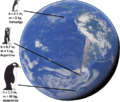Bergmann's rule facts for kids
Bergmann's rule is a cool idea in biogeography, which is the study of where living things are found on Earth. It says that animals of the same type tend to be bigger in colder places. Animals in warmer areas are usually smaller.
Think of it like this: if you have a group of animals that live in many different places, the ones living in chilly areas will likely be larger. The ones living in warm, tropical spots will probably be smaller.
Contents
What is Bergmann's Rule?
This rule helps us understand why animals have different sizes around the world. It's about how animals adapt to their environment. Larger bodies can hold heat better, which is helpful in cold climates. Smaller bodies lose heat faster, which is good in warm places.
Examples of Bergmann's Rule
You can see Bergmann's rule in many animals. For example, among bears, the polar bear is the largest. Polar bears live in the very cold Arctic. Smaller bears, like the panda, live in warmer, subtropical areas.
The biggest tiger is the Siberian tiger. It lives in cold parts of Russia and China. Tigers in warmer places, like India, are usually smaller. Even large mammals from the last ice age were generally bigger than their relatives today.
Who Discovered This Rule?
The rule is named after Carl Bergmann. He was a German biologist from the 1800s. He wrote about this pattern in 1847. Even though he wasn't the very first person to notice it, his name stuck with the rule.
How Does It Apply to Animals?
Bergmann's rule works well for many mammals and birds. These animals are called endotherms. This means they can make their own body heat. A larger body has less surface area compared to its volume. This helps big animals keep warm in cold weather.
Smaller animals have more surface area compared to their volume. This helps them cool down faster in hot weather. Scientists have also found signs of this rule in some ectotherms. Ectotherms are animals like reptiles and amphibians that get their body heat from outside sources.
Bergmann's Rule in the Past
Scientists have even seen Bergmann's rule in animals that are now extinct. They look at fossils to learn about animals from long ago. For example, some mammals became much smaller during very warm times in Earth's history. This "dwarfing" happened during brief warm periods in the Palaeogene era.
Images for kids
-
Bergmann's rule shown by red foxes. The northern fox is larger than the southern desert fox.
See also
 In Spanish: Regla de Bergmann para niños
In Spanish: Regla de Bergmann para niños


